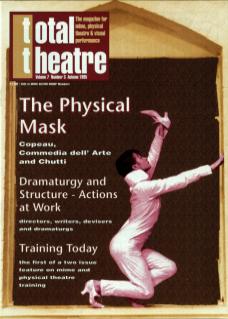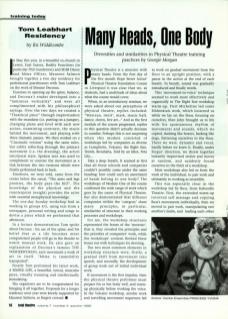Physical Theatre is a monster with many heads. From the first day of the five-month Hope Street Actors' Physical Theatre Foundation Course in Liverpool it was clear that we, as students, had a multitude of ideas about what the course would cover.
When, in an introductory seminar, we were asked about our perceptions of physical theatre, replies included: ‘“Marceau, innit”, mask, music hall, dance, clown, live art...’ And as the first module of the course progressed, replies to this question didn't actually decrease in number. Perhaps this is not surprising when this module consisted of workshops led by companies as diverse as Complicite, Volcano, The Right Size, Trestle, Brouhaha, Told by an Idiot, Peta Lily...
Take a deep breath. It seemed at first that all these schools and companies couldn't possibly come under the same heading: how could such an assortment of heads belong to one body? The workshops of Module One of the course confirmed the wide range of work which goes by the name of Physical Theatre, but also demonstrated that different companies within the category share many principles, in particular, similarities of structure in their working processes and workshops.
For me, the workshop structures represented the bones of the 'monster', that is, they revealed the principles and the priorities of companies' work, while the workshops' content fleshed these bones out with techniques for devising.
The two most common elements in workshop structure were, firstly, a gradual shift from movement into speech, and secondly, the development of group work out of initial individual work.
If movement is the first impulse, then the physical theatre performer must prepare his or her body well, and warm-up physically before working the voice. In the Volcano workshop, aerobic work and travelling movement sequences led to work on gradual movement from the floor to an upright position, with a pause in the action at the end of each breath. To breathe, sound was gradually introduced and finally words.
This 'movement-to-voice’ technique seemed to work most effectively and organically in The Right Size workshop warm-up. First Micheline led some Feldenkrais work, which loosened us while we lay on the floor, focusing on ourselves, then John brought us to life with his spontaneous rhythm of movements and sounds, which we copied, ducking like boxers, barking like dogs, flattening ourselves to the floor. There we were, dynamic and vocal, hardly before we knew it. Finally, under Fergus' direction, we threw together instantly improvised stories and moves at random, and suddenly found ourselves in the thick of a workshop.
Most workshops also led us from the work of the individual, to pair work, and ultimately to working as ensemble.
This was especially clear in the workshop led by Russ, from Kaboodle Theatre. First, the extended warm-up involved self massage and copying Russ' movements individually, then we moved to pair work, manipulating one another's limbs, and leading each other around the room blindfolded.
The next stage, the first involving group work, began with minimal movement, in an eye contact game into which more and more elements of speed and rhythm, movement and emotion were gradually introduced (barring the way with our arms to reject other players, stamping to show aggression, or hugging them in welcome). In the final part of the game, an intense group emotion began to smoulder as we added our own reactions to the actions of other players (sniggering at rejection, a sharp intake of breath at any show of aggression).
The ultimate phase of the workshop was the use of the Laban states ('wall', 'needle', 'ball' and 'twist'), which, in the established pattern, we practised individually and then used as a basis for a group contact improvisation.
There were many other similarities of workshop structure and content, such as the centrality of openness to play. It is important to recognise these similarities amongst practitioners when it seems that physical theatre is diversifying at such a rate that it is becoming alien to some of its own practitioners.
Realising this has had a strong effect on me as a performer: the Hope Street Course has not, of course, trained me fully as a physical theatre performer, but it has given me a strong idea of which areas I want to explore further, and an awareness that the heads of the 'monster' do share a unique body-vocabulary.


